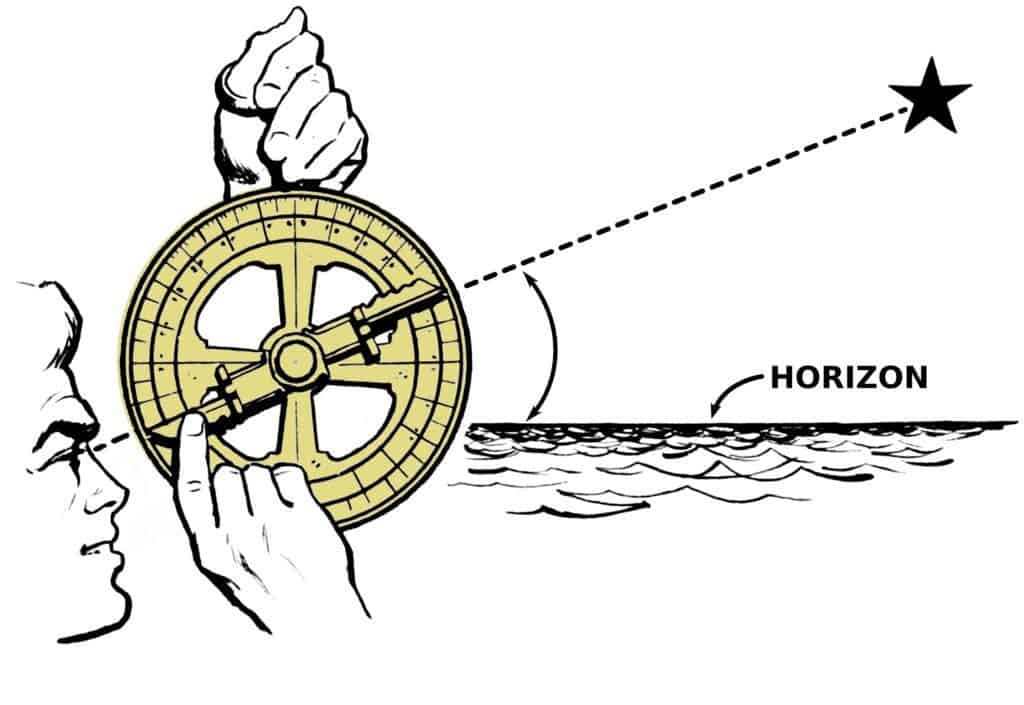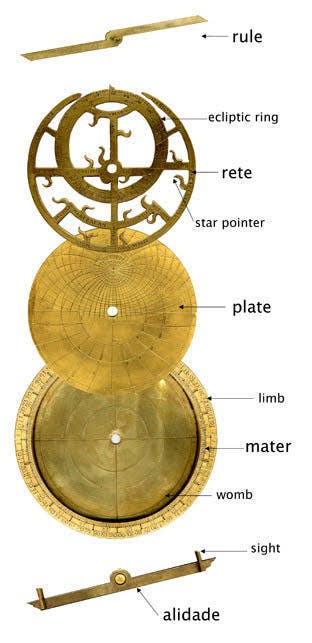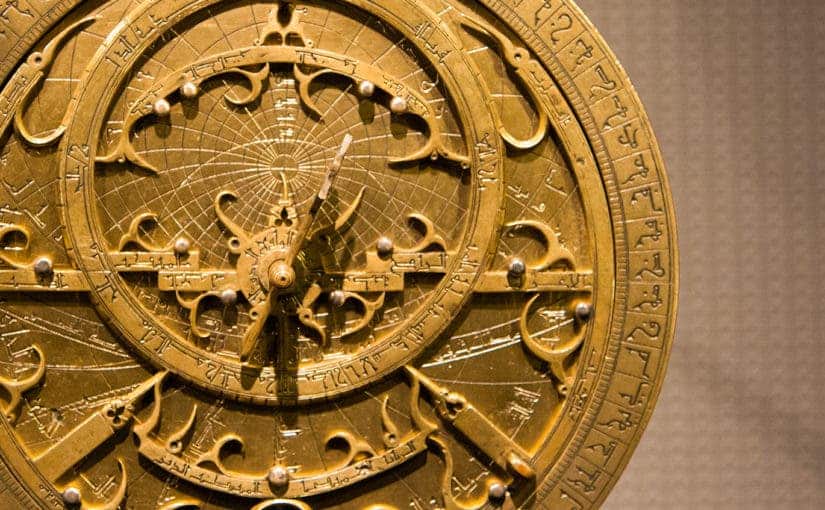
For centuries, the astrolabe was one of the fanciest pieces of astronomical technology employed by humans. It’s famous for guiding ships, acting as a sort of analog computer that helped navigators plot their geographical position by measuring the altitude of celestial bodies. However, the astrolabe is much more versatile than that. In the right hands, a trained individual can use the astrolabe to tell the exact time, predict star transits, planetary retrograde motions, and more.
It also doubled as an astrological tool, since during the astrolabe’s heyday astrology and astronomy were closely interlinked. People would turn to the astrolabe for important life predictions and decision-making based on the zodiac that was rising at the time of birth of the astrolabe’s wielder.
The name ‘astrolabe’ comes from Greek, meaning ‘star holder’. The inventor of this remarkable astronomical device has been lost to history, although some scholars credit Hipparchus, an ancient Greek astronomer and mathematician, with the invention of the disk-like tool, based on evidence from 160 B.C. that suggests he determined the precession of equinoxes in Rhodes. However, the astrolabe began to be widely used during the height of the Roman Empire, sometime between the 2nd and 4th century A.D. It is during this time that the most reliable surviving account of a device that fits the description of an astrolabe can be found in the writings of Roman astronomer Claudius Ptolemy. John Philoponos of Alexandria provides the earliest descriptions of actual astrolabes in the 6th century A.D.

In ancient times, the astrolabe was mainly used to tell the time, and not necessarily for navigation. This changed when the instrument was heavily modified and refined in the 9th century by scientists from the Islamic world. These upgrades included stereographic projections, which picture a sphere on a plane. The astrolabe was particularly useful to Islamic cultures, where it was used to determine prayer time and find the direction to Mecca, Islam’s holiest city.
Astrolabe technology changed hands, spreading from the Islamic world to Europe through North Africa and Spain in the 11th century. By the 13th century, European usage of the astrolabe was widespread.
It stayed in use for centuries by European and Islamic cultures up until the 18th century when it was replaced by more sophisticated technology.
How an astrolabe works

The astrolabe bears many similarities to the slide rule, both devices featuring graduated scales capable of relative movement, by means of which simple calculations may be carried out mechanically. The basic components of an astrolabe are the mater, plate, rete, rule, and alidade.
The mater (‘mother’ in Latin) is the disk-shaped base of the astrolabe that all of the other features slide out of, like the various tools of a Swiss Army knife. The rim of the mater is inscribed with scales, one for measuring the hours of the day and the outermost one for measuring degrees from 0 to 360.
The plate sits right within the mater and is etched with a two-dimensional projection of Earth’s latitudinal lines. More recent astrolabes contained a series of plates, each one depicting a specific latitude. The position of the stars changes depending on your geographical location (close to the equator the North Star, or Polaris, is no longer visible, for instance), so navigators needed a different plate for navigating the Mediterranean than they did around the tip of South America. Of note is that each plate was engraved with two kinds of circles: the first were circles of constant altitude known as almucantars (the horizon being the most important), the other were azimuths that met the almucantars at right angles (the meridian is the most important).

Over the plate, there’s the rete, a circular feature that points out the location of certain well-known stars in the sky, such as Sirius, Capella, Arcturus, and Spica. The unimportant bits of the rete were cut out so the skeletal ring could be superimposed on a plate. By rotating the rete around a central pin, known as the alidade, the navigator could predict the daily motion of celestial objects.
More recent astrolabes had a rule, which was marked with declinations from -30 degrees up to 70 degrees, which allowed for even more precise measurements. On the back of the astrolabe, the navigator could consult various scales and tables that were extremely useful in solving trigonometric problems useful in plotting a course on the sea.
Most surviving astrolabes are made of brass, extend about 15 centimeters (6 inches) in diameter, and are about a quarter-inch thick. They also look amazing, like veritable works of art, often embossed with intricate fine details and symbols, which is why they’re often associated with the educated elite of their time.
However, the most artful and beautiful astrolabes were also the sturdiest and cherished, often passed down from generation to generation as family heirlooms. The fact that most surviving astrolabes look amazing shouldn’t fool us into believing that was the norm — it’s just a case of selection bias. The vast majority of astrolabes were cheap and functional, likely made out of wood that rotted away and didn’t survive the passage of time. Others were made of metal and were likely melted in times of need.
Just 108 astrolabes have been recovered from shipwrecks, the oldest one being found on the Esmeralda, one of Vasco da Gama’s ships that sank near Oman during the pioneering voyage to India (1497-1499).
How to use an astrolabe
The astrolabe was used for dozens of purposes, but its foremost use was in measuring celestial altitude, meaning the relative ‘height’ of a star, moon or planet. By measuring the altitude of a star in the sky relative to the horizon, a mariner could compute latitude or the distance from the equator. Typically, sailors would measure the angle between the sun and the horizon during the day, and use Polaris (the North Star) at night.
The navigator would position the astrolabe by suspending or dangling the astrolabe from the ring at the top so that the device hangs perpendicular to the ocean. The alidade has two small holes which the sailor would use to sight the sun or star. The alidade needs to be positioned such that the sunlight comes through both holes. It’s then a matter of reading the angle measurement from the scale around the outer disk of the astrolabe. The degree measurement is the sun or other star’s altitude. To determine the ship’s latitude, the navigator would then have to compare the angle to that of star charts and tables, typically found on the back of the astrolabe.
At night, the astrolabe was held up to the eyeline. The sailor would then have to line up the pinholes of the alidade so that they could see the star through both holes. The angle would be consulted on the charts to determine the latitude.
Sailors had no means to determine longitude, but by knowing the latitude, they knew whether to sail east or west along the measured latitude to reach their destination. Without the astrolabe, famous explorers like Columbus and Magellan would have had much more challenging journeys across the oceans.
Despite its usefulness, the astrolabe was prone to error. A rolling ship and high winds would make it highly challenging to keep the instrument steady and a degree or two of errors were common. But even a slight error could throw a ship off course by a wide margin. Starting with the 17th century, the astrolabe was replaced by quadrants and sextants, which were much more accurate.
A fundamental astronomical tool for centuries
Despite its pseudoscience uses in astrology, the astrolabe made important contributions to science and was fundamental to the advent of modern astronomy. Giants like Galileo Galilei used it to make measurements of the movements of celestial bodies, track eclipses, and observe fundamental laws of nature. Though it may seem primitive my today’s standards, the astrolabe was fundamental in developing measurements and techniques that formed the foundation of today’s astronomical knowledge.


